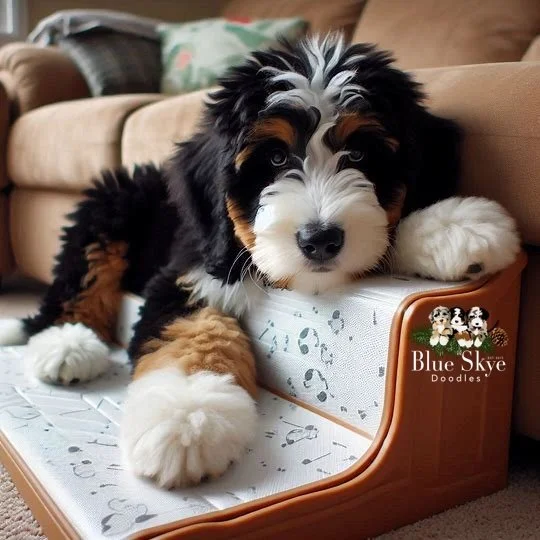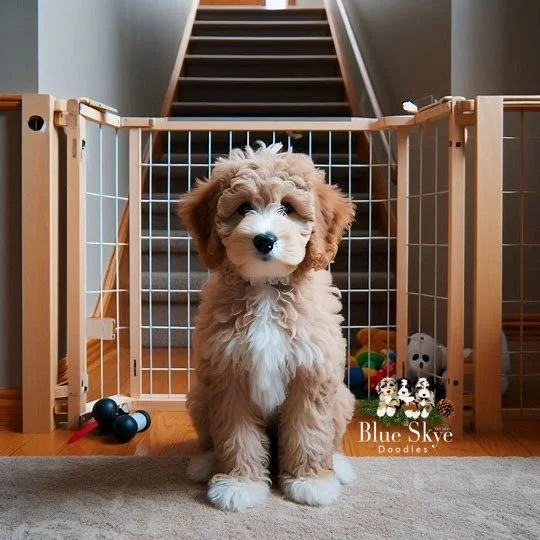
Exercise For Young Puppies
Age-Appropriate Exercise For Puppies
“A Tired Puppy is a Good Puppy” and safe exercise is good for a puppy’s mental and physical health. Some exercise builds strong bones and muscles. But exercise that’s not appropriate for a puppy’s age and development can cause significant damage.
Your first leash walks with a puppy should be in your home, preferably with the leash dragging on the floor. You can do a lot of training “off leash” in your home before you ever pick up the lead and walk out the door.
Once outside, keep it short and positive. Frequent short walks are better than infrequent long ones. Trying to force a puppy on a long walk will likely result in an overly tired, overwhelmed pup. They may just grind to a halt or grab the lead, jump around and just lose the plot.
These early walks ask a lot of our puppy as they are flooded with new experiences, sights and sounds. Traffic and commotion, weird new smells, new noises and people. Add in all the things we ask of them – pay attention, don’t pull on the lead, keep up with me, stay on one side. That isn’t even including commands we may add like “sit” or “down”.
While self play is usually safe, avoid having your puppy do any twisting or jumping up to grab a toy. Excessive, repetitive exercise on hard or rough surfaces are also to be avoided. So skip the frisbee and tug toys and no ball throwing for young puppies and adolescent dogs. Keep your ball game low and slow. Rolling on a gentle flat surface or smooth lawn.
Stairs…common sense applies. Young puppies should be carried up and down stairs for the first couple months. After that, walk them up and down slowly, on a harness and leash or holding onto their collar (for larger breeds). You want to control their ascent and descent so there is no falling, slipping, rolling, galloping and ultimately crashing at the bottom. Keep a kiddie/doggie gate at the top and bottom so they don’t use them as a racetrack. Not controlling and supervising stairs is a surefire way to ruin your dogs hips, elbows, patellas and more!
Running or jogging with your puppy isn’t recommended for at least the first year. When you are ready to start, remember you need to build your dog’s fitness level – gradually, with plenty of breaks for rest. Be mindful of the surface you are on, a cushioned track through a park is easier on joints and paw pads than rough asphalt.
Exercising with your dog will be a healthy adventure and decrease the chance of an overweight older dog. Being overweight WILL damage their joints regardless of the exercise. No breed should be fat and there is no excuse for it. Your vet can help you determine if they have a defined ‘waist” and appropriate body condition.
Feed according to how much they exercise, not necessarily how much the back of the bag says to feed them since it is usually overcalculated. Feeding dry kibble for all their meals, especially one high in carbohydrates will quickly add pounds so consider a fresh option for at least one daily meal if your dog is prone to weight gain.
Examples of Appropriate Exercise for Puppies under 18 Months
-

No Repetitive Exercise
Avoid repetitive exercises like jogging or long hikes. Most of your puppy’s exercise should be in the form of free-play, exploring and roaming. Short walks that allow him to rest and flop down when showing any fatigue.
-

Choose Puppy Playmates Wisely
Supervised play with a gentle playmate of similar size and strength or an older do who shows restraint is great exercise. Sometimes a gentle Giant is a better playmate than a rambunctious small dog.
-

Soft Landings
Keep puppies from jumping off of anything higher than their elbows like benches, sofas and beds. Use padded steps and/or cushioned beds below the sofa once thy are old enoug to be invited up on it.
-

Avoid Stairs
Stairs are not good for young hips. Studies have found that puppies who climbed flights of stairs daily before they were 3 months old had an increased risk of developing hip dysplasia. Flights of stairs can strain any puppy’s joints so carry them up or down until they are at least 6 months of age. One or two not too-steep non-slip stairs are safe and good for coordination.
-

Keep playtime grounded
Keep all play with toys on the ground. Roll balls instead of throwing them. Drag a toy on the floor and never hold any toy above a puppy’s head to make them jump for it. This is unsafe for their joints and neck and encourages future bad habits. 15 minutes of mental exercise will also tire out your puppy. Use puzzle toys or hide kibble under a ball in a muffin tin. Or spnd 15 minutes teaching a new trick.
-

Self-directed exercise on gentle hills
Encourage long-leash, self-directed exercise on gently rolling hills and varied, moderately soft ground and different surfaces. Especially important for puppies under 3 months of age to decrease the risk of developing hip dysplasia in the future.
Understanding Puppy Growth Plates
It is important to understand the concept of “growth plates". These are the soft area at the ends of the long bones in puppies and young dogs. They contain cells that allow the bones to become longer until the end of puberty.
Growth plates are gradually thinning as the puppy approaches puberty at which time hormonal changes signal the growth plates to close. In puppies this process is usually complete at the time of sexual maturity or around 18 months of age. Once the growth plates calcify, they become a stable and inactive part of the bone known as an epiphyseal line.
Until the growth plates close, they are very soft and vulnerable to injury.
Most of this growth will take place between 4 to 8 months of age but caution is still needed until they reach maximum bone density.
This is an X-ray of a 2 week old puppy. It clearly shows how far the bones have to grow before they become a proper joint!
Too much repetitive exercise or training during this time can cause injury. A dog’s bones are held together with muscles, tendons and ligaments - soft tissue. In an adult dog, a joint experiencing stress (over rotating, bending the wrong way, twisting etc.) would result in a soft tissue injury or sprain. In a young puppy however, the same stress injury could result in the soft tissue pulling apart the growth plate. Unlike a sprain, this type of injury may not heal in time for the puppy to mature correctly. This can result in a misshapen or shortened limb, creating an incorrect joint angle. Possibly making the puppy even more prone to injuries growing up.
50% off all fractures occur in puppies under 1 year of age.
Puppies bones and joints are designed for short runs, not lengthy walks. Puppies naturally exercise in small bursts of activity so work with their natural play ability and leave the endurance training for when they are all grown up.
The Role of Early Spay/Neuter on Your Puppy’s Joints
While we are on the subject of protecting puppies joints it is important to understand the role of early spay/neuter also.
Puppies growth plates calcify and become stable after sexual maturity. The bones of puppies spayed and neutered before puberty continue to grow. This can result in dogs with longer limbs, lighter bone structure, narrow chests and/or narrow skulls. These altered body proportions of certain bones aren’t just a cosmetic issue but may result in stress on ligaments and contribute to future injuries as well.
Published studies have found those spayed or neutered before 5-1/2 months of age were more likely to develop hip dysplasia. It is best to wait until at least 9 months of age for females and 12 months of age for males to ensure growth plates have closed for the majority of breeds/sizes.
Please read our recommendations and information on age appropriate desexing.


